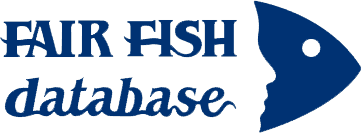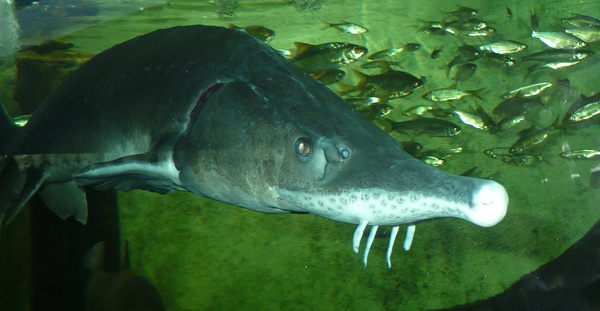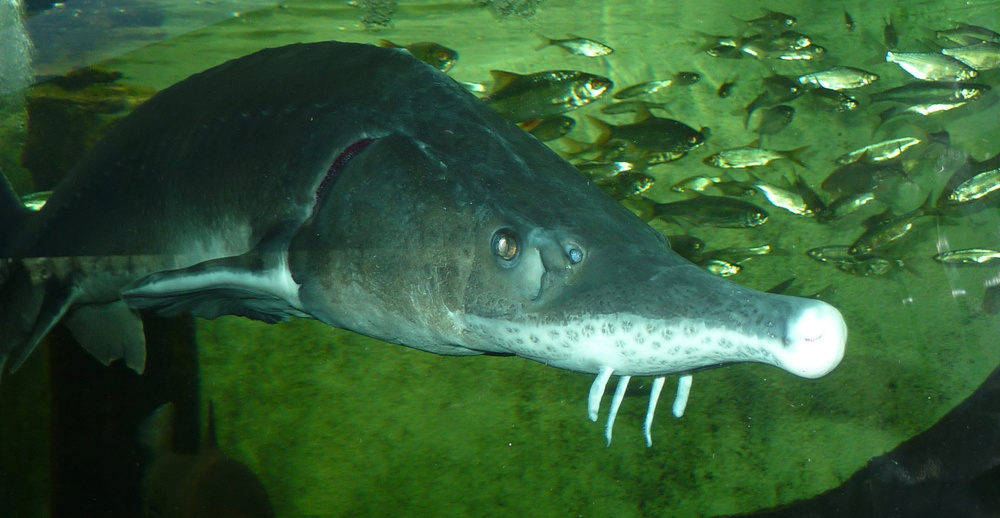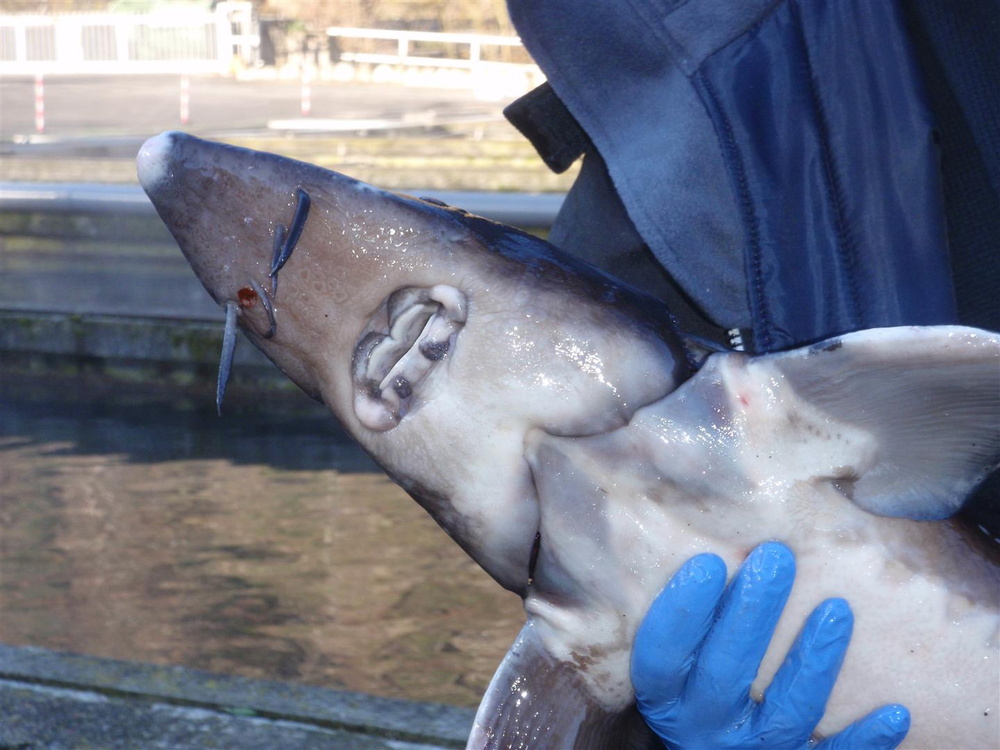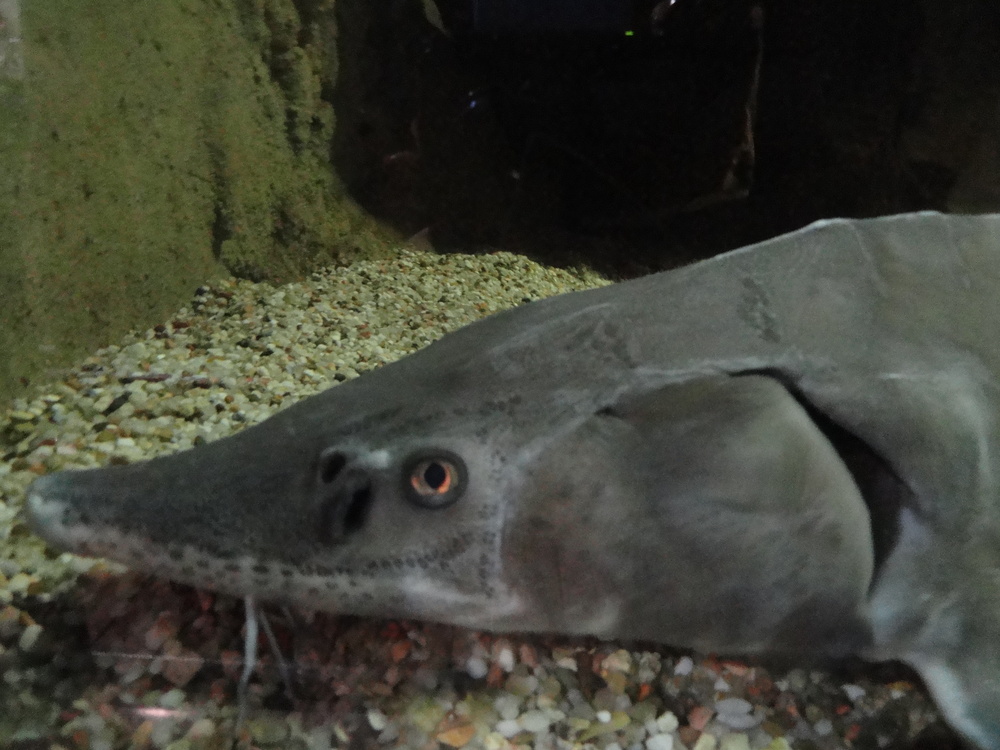Information
Version: B | 1.1 (2021-12-21)
WelfareScore | farm
Condensed assessment of the species' likelihood and potential for good fish welfare in aquaculture, based on ethological findings for 10 crucial criteria.
- Li = Likelihood that the individuals of the species experience good welfare under minimal farming conditions
- Po = Potential of the individuals of the species to experience good welfare under high-standard farming conditions
- Ce = Certainty of our findings in Likelihood and Potential
WelfareScore = Sum of criteria scoring "High" (max. 10)
General remarks
Acipenser baerii, an endangered species according to the IUCN redlist, has been farmed for over a century, but only recently the full life cycle has been successfully closed in aquaculture. Sturgeons are mostly reared for caviar, and while its production started in the former USSR, A. baerii production is now present in Belgium, China, Italy, Germany, Hungary, Poland, Spain, Switzlerland, and the United States of America. However, there are many aspects of welfare that are being overlooked: usual rearing tanks are too small, spawning induction is highly invasive, it requires proper substrate in all stages of its life cycle, and the establishment of a humane slaughter protocol is still missing. Although some effort is being undertaken, fish components are still present in the feed. Many aspects of its biology remain unclear and require further investigation.
1 Home range
Many species traverse in a limited horizontal space (even if just for a certain period of time per year); the home range may be described as a species' understanding of its environment (i.e., its cognitive map) for the most important resources it needs access to.
What is the probability of providing the species' whole home range in captivity?
It is unclear for minimal farming conditions. It is medium for high-standard farming conditions. Our conclusion is based on a medium amount of evidence.


2 Depth range
Given the availability of resources (food, shelter) or the need to avoid predators, species spend their time within a certain depth range.
What is the probability of providing the species' whole depth range in captivity?
It is low for minimal and high-standard farming conditions. Our conclusion is based on a medium amount of evidence.


3 Migration
Some species undergo seasonal changes of environments for different purposes (feeding, spawning, etc.), and to move there, they migrate for more or less extensive distances.
What is the probability of providing farming conditions that are compatible with the migrating or habitat-changing behaviour of the species?
It is low for minimal farming conditions. It is medium for high-standard farming conditions. Our conclusion is based on a medium amount of evidence.


4 Reproduction
A species reproduces at a certain age, season, and sex ratio and possibly involving courtship rituals.
What is the probability of the species reproducing naturally in captivity without manipulation of these circumstances?
It is low for minimal farming conditions. It is medium for high-standard farming conditions. Our conclusion is based on a medium amount of evidence.


5 Aggregation
Species differ in the way they co-exist with conspecifics or other species from being solitary to aggregating unstructured, casually roaming in shoals or closely coordinating in schools of varying densities.
What is the probability of providing farming conditions that are compatible with the aggregation behaviour of the species?
It is unclear for minimal farming conditions. It is medium for high-standard farming conditions. Our conclusion is based on a low amount of evidence.


6 Aggression
There is a range of adverse reactions in species, spanning from being relatively indifferent towards others to defending valuable resources (e.g., food, territory, mates) to actively attacking opponents.
What is the probability of the species being non-aggressive and non-territorial in captivity?
It is unclear for minimal farming conditions. It is medium for high-standard farming conditions. Our conclusion is based on a low amount of evidence.


7 Substrate
Depending on where in the water column the species lives, it differs in interacting with or relying on various substrates for feeding or covering purposes (e.g., plants, rocks and stones, sand and mud, turbidity).
What is the probability of providing the species' substrate and shelter needs in captivity?
It is low for minimal farming conditions. It is medium for high-standard farming conditions. Our conclusion is based on a medium amount of evidence.


8 Stress
Farming involves subjecting the species to diverse procedures (e.g., handling, air exposure, short-term confinement, short-term crowding, transport), sudden parameter changes or repeated disturbances (e.g., husbandry, size-grading).
What is the probability of the species not being stressed?
It is low for minimal farming conditions. It is medium for high-standard farming conditions. Our conclusion is based on a low amount of evidence.


9 Malformations
Deformities that – in contrast to diseases – are commonly irreversible may indicate sub-optimal rearing conditions (e.g., mechanical stress during hatching and rearing, environmental factors unless mentioned in crit. 3, aquatic pollutants, nutritional deficiencies) or a general incompatibility of the species with being farmed.
What is the probability of the species being malformed rarely?
It is low for minimal farming conditions. It is high for high-standard farming conditions. Our conclusion is based on a medium amount of evidence.


10 Slaughter
The cornerstone for a humane treatment is that slaughter a) immediately follows stunning (i.e., while the individual is unconscious), b) happens according to a clear and reproducible set of instructions verified under farming conditions, and c) avoids pain, suffering, and distress.
What is the probability of the species being slaughtered according to a humane slaughter protocol?
It is low for minimal farming conditions. It is high for high-standard farming conditions. Our conclusion is based on a medium amount of evidence.


Side note: Domestication
Teletchea and Fontaine introduced 5 domestication levels illustrating how far species are from having their life cycle closed in captivity without wild input, how long they have been reared in captivity, and whether breeding programmes are in place.
What is the species’ domestication level?
DOMESTICATION LEVEL 5 36, fully domesticated.
Side note: Forage fish in the feed
450-1,000 milliard wild-caught fishes end up being processed into fish meal and fish oil each year which contributes to overfishing and represents enormous suffering. There is a broad range of feeding types within species reared in captivity.
To what degree may fish meal and fish oil based on forage fish be replaced by non-forage fishery components (e.g., poultry blood meal) or sustainable sources (e.g., soybean cake)?
All age classes: WILD: carnivorous 2. FARM: fish meal may be mostly* 37 38 39 or completely* replaced by plant protein 40 41 and partially* replaced by poultry by-products 42 43.
*partly = <51% – mostly = 51-99% – completely = 100%
Glossary
ANADROMOUS = migrating from the sea into fresh water to spawn
BENTHIC = living at the bottom of a body of water, able to rest on the floor
DOMESTICATION LEVEL 5 = selective breeding programmes are used focusing on specific goals 36
FARM = setting in farming environment or under conditions simulating farming environment in terms of size of facility or number of individuals
FINGERLINGS = early juveniles with fully developed scales and working fins, the size of a human finger; for details ➝ Findings 10.1 Ontogentic development
IND = individuals
JUVENILES = fully developed but immature individuals, for details ➝ Findings 10.1 Ontogenetic development
LAB = setting in laboratory environment
LARVAE = hatching to mouth opening, for details ➝ Findings 10.1 Ontogenetic development
PELAGIC = living independent of bottom and shore of a body of water
PLANKTONIC = horizontal movement limited to hydrodynamic displacement
SPAWNERS = adults during the spawning season; in farms: adults that are kept as broodstock
WILD = setting in the wild
Bibliography
2 Doroshov, Sergei I. 1985. Biology and Culture of Sturgeon Acipenseriformes. In Recent Advances in Aquaculture, ed. James F. Muir and Ronald J. Roberts, 251–274. Boston, MA: Springer US.
3 Chebanov, Mikhail S., and Elena V. Galich. 2011. Sturgeon hatchery manual. FAO Fisheries and Aquaculture Technical Paper 558. Ankara: Food and Agriculture Organization of the United Nations.
4 Williot, P, P Bronzi, P Benoit, E Bonpunt, Mihail Chebanov, A Domezain, J Gessner, et al. 2005. Cultured Aquatic Species Information Programme. Acipenser baerii. Rome: FAO Fisheries and Aquaculture Department.
5 Köksal, Gülten, Ferit Rad, and Mevlüt Kindir. 2000. Growth performance and feed conversion efficiency of Siberian sturgeon juveniles (Acipenser baeri) reared in concrete raceways. Turkish Journal of Veterinary and Animal Sciences 24: 435–442.
6 Saraiva, João L. 2018. Personal communication.
7 FAO. 2017. FAO Fisheries & Aquaculture - Species Fact Sheets - Acipenser baerii (Brandt, 1869). World Wide Web electronic publication. www.fao.org.
8 Bemis, William E., and Boyd Kynard. 1997. Sturgeon rivers: an introduction to acipenseriform biogeography and life history. Environmental Biology of Fishes 48: 167–183. https://doi.org/10.1023/A:1007312524792.
9 Holčík, Juraj. 1989. The Freshwater Fishes of Europe: General introduction to fishes ; Acipenseriformes. AULA - Verlag.
10 Rodríguez, A., M.A. Gallardo, E. Gisbert, S. Santilari, A. Ibarz, J. Sánchez, and F. Castelló-Orvay. 2002. Osmoregulation in juvenile Siberian sturgeon (Acipenser baerii). Fish Physiology and Biochemistry 26: 345–354. https://doi.org/10.1023/B:FISH.0000009263.83075.68.
11 Gisbert, Enric, and Patrick Williot. 1997. Larval behaviour and effect of the timing of initial feeding on growth and survival of Siberian sturgeon (Acipenser baeri) larvae under small scale hatchery production. Aquaculture 156: 63–76. https://doi.org/10.1016/S0044-8486(97)00086-0.
12 Gisbert, E. 1999. Early development and allometric growth patterns in Siberian sturgeon and their ecological significance. Journal of Fish Biology 54: 852–862. https://doi.org/10.1111/j.1095-8649.1999.tb02037.x.
13 Gisbert, E., and P. Williot. 2002. Advances in the larval rearing of Siberian sturgeon. Journal of Fish Biology 60: 1071–1092. https://doi.org/10.1111/j.1095-8649.2002.tb01705.x.
14 Birstein, Vadim J., and Georgii I. Ruban. 2004. A comment on the Siberian, Acipenser baerii, and Russian, Acipenser gueldenstaedtii, sturgeons. Environmental Biology of Fishes 70: 91–92.
15 Rochard, Eric, G. Castelnaud, and Mario Lepage. 1990. Sturgeons (Pisces: Acipenseridae); threats and prospects. Journal of Fish Biology 37: 123–132. https://doi.org/10.1111/j.1095-8649.1990.tb05028.x.
16 Bronzi, P., H. Rosenthal, G Arlati, and P. Williot. 1999. A brief overview on the status and prospects of sturgeon farming in Western and Central Europe. Journal of Applied Ichthyology 15: 224–227. https://doi.org/10.1111/j.1439-0426.1999.tb00239.x.
17 Williot, P, P Bronzi, and G Arlati. 1993. A very brief survey of status and prospects of freshwater sturgeon farming in Europe (EEC). In Workshop on aquaculture of freshwater species (except salmonids), Ghent, Belgium, EAS Special Publication, 20:32–36.
18 Simide, Rémy, Simone Richard, Nathalie Prévot-D’Alvise, Thomas Miard, and Sandrine Gaillard. 2016. Assessment of the accuracy of physiological blood indicators for the evaluation of stress, health status and welfare in Siberian sturgeon (Acipenser baerii) subject to chronic heat stress and dietary supplementation. International Aquatic Research 8: 121–135. https://doi.org/10.1007/s40071-016-0128-z.
19 Ruban, Georgii I. 1997. Species structure, contemporary distribution and status of the Siberian surgeon Acipenser baerii. Environmental Biology of Fishes 48: 221–230. https://doi.org/10.1023/A:1007372932444.
20 Billard, Roland, and Guillaume Lecointre. 2001. Biology and conservation of sturgeon and paddlefish. Reviews in Fish Biology and Fisheries 10: 355–392. https://doi.org/10.1023/A:1012231526151.
21 Gisbert, Enric, and Georgii I. Ruban. 2003. Ontogenetic behavior of Siberian sturgeon, Acipenser baerii: A synthesis between laboratory tests and field data. Environmental Biology of Fishes 67: 311–319. https://doi.org/10.1023/A:1025851502232.
22 Hatin, D., R. Fortin, and F. Caron. 2002. Movements and aggregation areas of adult Atlantic sturgeon (Acipenser oxyrinchus) in the St Lawrence River estuary, Quebec, Canada. Journal of Applied Ichthyology 18: 586–594. https://doi.org/10.1046/j.1439-0426.2002.00395.x.
23 Billard, R. 2000. Biology and control of reproduction of sturgeons in fish farm. Iranian Journal of Fisheries Sciences 2: 1–20.
24 Allen, P. J., C. C. Barth, S. J. Peake, M. V. Abrahams, and W. G. Anderson. 2009. Cohesive social behaviour shortens the stress response: the effects of conspecifics on the stress response in lake sturgeon Acipenser fulvescens. Journal of Fish Biology 74: 90–104. https://doi.org/10.1111/j.1095-8649.2008.02112.x.
25 Vecsei, P., and D. Peterson. 2004. Sturgeon Ecomorphology: A Descriptive Approach. In Sturgeons and Paddlefish of North America, 103–133. Fish & Fisheries Series. Springer, Dordrecht. https://doi.org/10.1007/1-4020-2833-4_6.
26 Ruban, GI, and LA Konoplya. 1994. Diet of the Siberian Sturgeon, Acipenser baeri, in the Indigirka and Kolyma rivers. Journal of Ichthyology/Voprosy Ikhtiologii: 1.
27 Kottelat, Maurice, and Jörg Freyhof. 2007. Handbook of European freshwater fishes. Publications Kottelat.
28 Froese, R., and D. Pauly. 2014. FishBase. World Wide Web electronic publication. www.fishbase.org.
29 Hj, Hamlin, Edwards Tm, Moore Bc, Main Kl, and Guillette LJ Jr. 2006. Stress and its relation to endocrine function in captive female Siberian sturgeon (Acipenser baeri). Environmental sciences : an international journal of environmental physiology and toxicology 14: 129–139.
30 Eslamloo, Khalil, and Bahram Falahatkar. 2014. Variations of Some Physiological and Immunological Parameters in Siberian Sturgeon (Acipenser baerii, Brandt, 1869) Subjected to an Acute Stressor. Journal of Applied Animal Welfare Science 17: 29–42. https://doi.org/10.1080/10888705.2014.856243.
31 Williot, Patrick, Sylvain Comte, and F. Le Menn. 2011. Stress indicators throughout the reproduction of farmed Siberian sturgeon Acipenser baerii (Brandt) females. Stress 3.
32 Gisbert, Enric, Adriana Rodriguez, Francesc Castelló-Orvay, and Patrick Williot. 1998. A histological study of the development of the digestive tract of Siberian sturgeon (Acipenser baeri) during early ontogeny. Aquaculture 167: 195–209. https://doi.org/10.1016/S0044-8486(98)00312-3.
33 Gisbert, E, P Williot, and F Castelló-Orvay. 2000. Influence of egg size on growth and survival of early stages of Siberian sturgeon (Acipenser baeri) under small scale hatchery conditions. Aquaculture 183: 83–94. https://doi.org/10.1016/S0044-8486(99)00287-2.
34 Gisbert, Enric, and Patrick Williot. 2002. Influence of Storage Duration of Ovulated Eggs Prior to Fertilisation on the Early Ontogenesis of Sterlet (Acipenser ruthenus) and Siberian Sturgeon (Acipenser baeri). International Review of Hydrobiology 87: 605–612. https://doi.org/10.1002/1522-2632(200211)87:5/6<605::AID-IROH605>3.0.CO;2-#.
35 Williot, Patrick, Mikhail Chebanov, and Guy Nonnotte. 2018. Welfare in the Cultured Siberian Sturgeon, Acipenser baerii Brandt: State of the Art. In The Siberian Sturgeon (Acipenser baerii, Brandt, 1869) Volume 2 - Farming, 403–450. Springer, Cham. https://doi.org/10.1007/978-3-319-61676-6_19.
36 Teletchea, Fabrice, and Pascal Fontaine. 2012. Levels of domestication in fish: implications for the sustainable future of aquaculture. Fish and Fisheries 15: 181–195. https://doi.org/10.1111/faf.12006.
37 Ronyai, A., I. Csengeri, and L. Varadi. 2002. Partial substitution of animal protein with full-fat soybean meal and amino acid supplementation in the diet of Siberian sturgeon (Acipenser baerii). Journal of Applied Ichthyology 18: 682–684. https://doi.org/10.1046/j.1439-0426.2002.00372.x.
38 Palmegiano, Giovanni B, Elisabetta Agradi, Gilberto Forneris, Francesco Gai, Laura Gasco, Elisabetta Rigamonti, Benedetto Sicuro, and Ivo Zoccarato. 2005. Spirulina as a nutrient source in diets for growing sturgeon (Acipenser baeri). Aquaculture Research 36: 188–195. https://doi.org/10.1111/j.1365-2109.2005.01209.x.
39 Mazurkiewicz, Jan, Antoni Przybył, and Janusz Golski. 2009. Usability of some plant protein ingredients in the diets of Siberian sturgeon Acipenser baerii Brandt. Archives of Polish Fisheries 17. https://doi.org/10.2478/v10086-009-0002-3.
40 Kaushik, S.J., J. Breque, and D. Blanc. 1994. Apparent amino acid availability and plasma free amino acid levels in Siberian sturgeon (Acipenser baeri). Comparative Biochemistry and Physiology Part A: Physiology 107: 433–438. https://doi.org/10.1016/0300-9629(94)90403-0.
41 Yun, B., M. Xue, J. Wang, H. Sheng, Y. Zheng, X. Wu, and J. Li. 2014. Fishmeal can be totally replaced by plant protein blend at two protein levels in diets of juvenile Siberian sturgeon, Acipenser baerii Brandt. Aquaculture Nutrition 20: 69–78. https://doi.org/10.1111/anu.12053.
42 Xue, M., B. Yun, J. Wang, H. Sheng, Y. Zheng, X. Wu, Y. Qin, and P. Li. 2012. Performance, body compositions, input and output of nitrogen and phosphorus in Siberian sturgeon, Acipenser baerii Brandt, as affected by dietary animal protein blend replacing fishmeal and protein levels. Aquaculture Nutrition 18: 493–501. https://doi.org/10.1111/j.1365-2095.2011.00908.x.
43 Zhu, H., G. Gong, J. Wang, X. Wu, M. Xue, C. Niu, L. Guo, and Y. Yu. 2011. Replacement of fish meal with blend of rendered animal protein in diets for Siberian sturgeon (Acipenser baerii Brandt), results in performance equal to fish meal fed fish: Alternative protein utilization for Siberian sturgeon. Aquaculture Nutrition 17: e389–e395. https://doi.org/10.1111/j.1365-2095.2010.00773.x.




